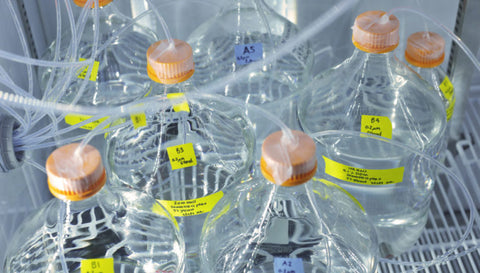Purifying Proteins in Denaturing Conditions

This blog post about denaturing conditions is the second in a series about optimizing conditions for affinity protein purification. Read parts one and three.
Maintaining a protein’s folding structure is a key element of achieving a successful purification. Some proteins are insoluble in solution due to their folding properties which prevent their binding to chromatography resin. Using denaturing conditions is a way to coax insoluble proteins into solution by reducing hydrophobic effects and unfolding the aggregates. Denaturing agents are also useful for testing protein folding dynamics, protein elution from a column, and regenerating a resin column. This blog post will focus on the use of denaturing conditions in the context of affinity protein purification.
What are denaturing conditions?
Denaturing conditions refer to the presence of chaotropic compounds in solution that cause unfolding in the structure of proteins.
The two most commonly used chaotropes are:
Protein stability depends in part on the hydrogen bond networks in the solvent, and urea and Gdn both interfere with the hydrogen bonding networks of water molecules in solution. However, urea also hydrogen bonds directly with the protein backbone to disrupt structure while Gdn does not.
It is helpful to have multiple options for denaturants because not all affinity purification systems can tolerate the same denaturing parameters. An example of an affinity tag purification system with sensitivity to Gdn-HCl is eXact. In the eXact system, cleavage of the subtilisin prodomain (eXact’s tag) is triggered by fluoride, chloride, and azide-containing solutions. Gdn-HCl causes this reaction to occur prematurely early and could prevent achieving a full yield.
Similarly, Halo can’t use Gdn or urea because both interfere with the binding interaction between tag and ligand. In TriAltus’ CL7 system, Gdn will cause the CL7 tag to dissociate from the Im7 ligand on the resin bead.
In general, purification systems that rely on specific protein-protein interactions are likely to be sensitive to denaturants, although to different degrees. In contrast, the His-tag relies on the interaction between His and metal ions, so it is not sensitive to denaturants.
Therefore, it is useful to know any denaturant sensitivities beforehand when choosing a system for affinity purification.
When are denaturing conditions used?
Purifying insoluble proteins
The primary motive for using denaturing conditions is to purify insoluble proteins. When expressed in E. coli, these proteins form inclusion bodies that need to be disaggregated in order to produce native protein. A possible workflow for purifying proteins from inclusion bodies might proceed as follows:
- Sonicate cells
- Isolate inclusion bodies from E. coli (or cells using a different system)
- Resuspend and denature in buffer
- Slowly dialyze overnight to remove denaturant
- Continue with purification
Inclusion bodies are already enriched for the overexpressed protein, which allows one to refold directly before performing a chromatography step. It is also possible to refold while the protein is bound to a column. The thought is that refolding on the column separates the molecules and prevents aggregation before refolding occurs. Using denaturing conditions throughout the purification process can also lead to higher purity because fewer cellular proteins will have the ability to stick to the resin.
Troubleshooting tests
Denaturing conditions can also be helpful for small-scale troubleshooting tests. One example is if the protease seems unable to cleave the protein. Steric hindrance during proteolytic elution could be preventing proper cleavage. As a workaround, the protein can be eluted with Gdn and run on a gel to see if the protein was cleaved but got stuck to the column, or whether it was never cleaved in the first place.
Another test using denaturants is to verify quickly that the purification worked. The protein is eluted with a denaturant, and the unfolded protein is run on an SDS gel for the sake of identifying that the protein was purified with sufficient purity, which does not require proper folding.
Note: Gdn will precipitate when mixed with SDS and should be exchanged for urea by dialysis prior to gel analysis.
Column regeneration
Finally, denaturants are a critical element of column regeneration. Once a protein has been removed from its column, the column is washed with Gdn to remove remnants of the tag. The denaturant is gradually replaced with salt buffer which triggers the refolding of the ligand on the resin, allowing it to be reused.
Test TriAltus' regenerable Im7 resin columns yourself
Conclusion
Denaturing conditions are useful beyond elution practices. They can be the difference between failure and success for purifying insoluble proteins and allow for small tests to confirm purification quality.
Read about using Gdn to regenerate the Im7 resin column in our protocol.
